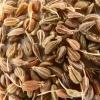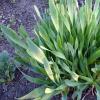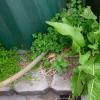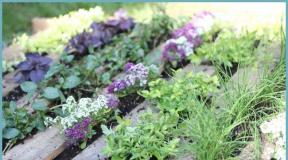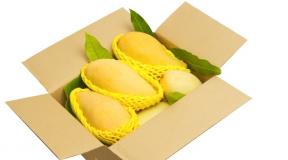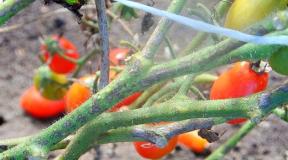What greens to plant in the vegetable garden for salads. Pick and Eat: Delicious and healthy greens in your garden. General rules for seed preparation
Having your own plot and buying spicy herbs in the market is, to put it mildly, unreasonable. You can grow everything in your garden and always have the freshest greens on the table, and be sure of its environmental friendliness. In our article you will find a list of herbs, recommendations for growing perennial and annual plants, photos with names and main characteristics.
Fragrant garden: preparation
Even from a small free space, using it rationally, you can get the most out of it. An ordinary garden bed and a flower bed - oval, triangular or round - are suitable for spicy herbs.
A bed with spicy greens looks beautiful, and everything planted on it is useful, but so that the greens do not lose their decorativeness, it needs care. Therefore, you need to arrange the garden so that it is convenient to work.
In addition, there should be free access to the bed even in bad weather, therefore, paths paved with slabs or brick are needed, in extreme cases they can be covered with sawdust.

Herb garden
Plants are tall, planted in the center, lower ones - along the edge. They begin to prepare the place in the fall: they remove the weeds, dig it up. In the spring, they clean the soil from weeds again, loosen it, then:
- outline the paths;
- limit the bed with a border, for which, with the help of a cord, they beat off the borders and set pegs;
- make a brick border or assemble a frame from boards;
- fill the garden with fertile soil, water;
- pave the passages;
- seedlings are planted.
Attention! Most spicy plants do not tolerate excess moisture. Therefore, if the bed is in a lowland, then a good drainage layer is needed.
Perennial herbs
The detachment of perennial spicy herbs is:
- Fennel. Reaches 1.5 m, most often grown as an annual, because he is southerner and cannot stand harsh winters. All its parts are used in the kitchen. The grains are used as a seasoning for fish, they decorate dishes with beautiful leaves, the heads of cabbage are stewed and served with meat.

- Lovage. A powerful, unpretentious spice plant, reaching 2 m. It is planted both in the sun and in the shade - it feels good everywhere. Its leaves are a spicy seasoning for fish and meat dishes. The plant is a frequent ingredient in traditional medicine.
- Hyssop. It is a half-meter, and sometimes even taller, fragrant dwarf shrub. Very picturesque when in bloom. Its flowers are most often purple or blue, but pink ones are also found. A spicy seasoning from its buds and leaves is used for salads, sauces, soups, meat and fish. It is a good flavoring agent for marinades, tinctures.

- Ruta. This is a half-shrub 50-70 cm in height. Unpretentious, reproduces in all known ways. As a seasoning it is good for lamb, meat fillings, vegetables, put in jars when canning tomatoes, cucumbers.
- Lemon balm is a bush 0.45-1.25 m tall, branched, growing well in the sun and in a slightly shaded place, the main thing is that the soil is fertile. Has a citrus flavor, is used in many dishes, giving them a bright taste.

Lemon melissa
- Garden thyme. Low shrub 0.25-0.4 m. In addition to widespread use for medicinal purposes, it is also a good seasoning for soups, salads, sauces, fish, meat, vegetables.
- Sage is a powerful plant with panicle-shaped inflorescences, sometimes reaching 1.2 m. It is useful both in the kitchen and in medicine.
Attention! Individual plants enhance the taste of the herbs that grow with them in the neighborhood. These include kanuper, nivyanik, wormwood.
Spicy annuals
A garden bed with herbs is not only perennials; without annual aromatic plants, it will be incomplete. This list includes:
- Anise. It grows on light and fertile soil, loves light. It can grow over a meter. Collect fresh herbs to season salads, side dishes. The seeds are added to sauces, baked goods, pickles, soups, kvass, sourdoughs.

- Dill. It is worth planting this plant once, how further it will multiply itself through self-seeding. It is difficult to name a dish wherever dill is used, well, unless it is added to sweets.
- Basil. It grows in the form of a small compact bush, thermophilic, so it is better to grow it through seedlings. Fresh leaves are served with kebabs, used as a seasoning for many dishes. The twigs are used for conservation.
- Parsley is an essential ingredient in many dishes. Both the leaves and the root are used. Grows in a bright place, prefers loose soils, is not afraid of frost.
- Borago or cucumber herb. This plant with beautiful blue star-shaped flowers is a good addition to side dishes, meat, vinaigrette, fish, cold soups, sauces. In addition, mature leaves are stewed, like spinach, added to marinades, pickles. Both fresh and candied flowers are edible. Bushes can grow from 10 to 60 cm in height.

Borago or cucumber herb
- Coriander. In appearance, 80-centimeter bushes cannot be immediately distinguished from parsley, but the taste and aroma of cilantro are completely different. The plant is not capricious, it grows in the garden without much attention to itself. Greens are good in salads, as a seasoning for soups, meat. Seeds are an irreplaceable spice for sausages, canned food, sauces, drinks, pickles.
- Mustard salad. Surprisingly early maturing, cold-resistant plant. In the home kitchen, they use its succulent leaves, which are harvested before the flowers appear. They are put in salads, made a side dish, canned. Oil is obtained from seeds, mustard is made. The powder made from seeds is used as a seasoning for fish and meat. It is included in gingerbread mixtures. This spice makes the stomach work more actively, increases appetite.

Mustard salad
- Floral marjoram. Unlike the leaf marjoram, which grows exclusively in the south, the floral one belongs to annuals and is cultivated in Europe. Spicy leaves and flower buds that have not yet blossomed are used. The latter are dried, fried, added to dishes fresh. This spice can be found in the Ingredient List for Hop-Suneli Mix. The housewives generously season them with fried and stewed poultry, pork, add to cabbage, legumes, potatoes, minced meat, marinade, pates, drinks, mushroom, meat soups.
- Caraway. An ancient spice plant up to 1 m tall, it is more correct to call it a biennial. Seeds are mainly used as a flavoring for bread and other baked goods. Included in the list of spices for meat, gravy, vegetables, sauce, kvass. The root and leaves are put in salads. The essential oil made from seeds has a peculiar aroma.

- Kupyr is another representative of the umbrella family that prefers shade. It tastes very similar to parsley, but has a slightly sweet smell, typical of anise. As a spice is added with fresh leaves, both taste and useful properties are lost in the dried form. There is kupyr in sauces, oils, it is added to cottage cheese when making sandwiches.
Advice. Marjoram will help you to endure the salt-free diet better. It is also useful for diabetics as a salt substitute.
A spicy bed is not only healthy, but also beautiful. Set aside a place for her in your garden and she will provide you with tasty additions to dishes, and if necessary, she will cure many ailments.
A flower bed of herbs: video
Spicy herbs: photo







Although summer residents, who have the opportunity to add fresh, varied and clean greens to their diet from early spring to late autumn, usually feel well its healing effects. In addition, the cultivation of these crops is not burdened with great difficulties and is accessible even to beginners. "AiF. At the Dacha ”recommends readers not to limit themselves to the standard“ pair ”of dill and parsley, but to have an expanded assortment of green crops. Fortunately, the choice is huge.
Sowing non-stop
Many green crops give us the opportunity to grow them throughout the summer so that the harvest goes smoothly to the family table. Everyone knows about dill and parsley, so we will dwell in more detail on other types of greens for the "conveyor".
Beauty recipes
To refresh the skin of the face, eliminate age spots and wrinkles, in the morning and in the evening it is necessary to wipe the face with a decoction of parsley: 3 tbsp. tablespoons of chopped leaves boil for 15 minutes in 1 glass of water. Strain the broth, cool, and then wipe your face with the resulting product.
Regular compresses of chilled parsley decoction help to get rid of dark circles under the eyes. And the fresh leaves of this plant are a wonderful remedy for mosquito and bee stings.
In cosmetology, they also use gruel from crushed leaves and sour cream - it is applied to the face as a nourishing mask. It gives freshness and elasticity to the skin of the face.
Salad
| Kutaby with herbs | |
|---|---|
| For the test: wheat flour - 600 g, water - about 150 g, salt. Filling: any garden or wild herbs - 600 g, onions - 200 g, cilantro - 300 g, cottage cheese - 100 g, butter - 100 g, sour milk - 1 glass. Preparation... Knead the dough from flour, water and salt and let it "lie down" for at least 30 minutes. Chop the greens as small as possible, add the cottage cheese and mix. Roll out the dough into a thick rope, cut into pieces and roll out in circles the size of a small plate. Put the filling on half of the circle, close with the other half and pinch in the shape of a crescent. Fry kutabs in a dry frying pan on both sides, ready-made - grease with butter, stack and serve with sour milk. |
|
The leaves contain all vitamins known to science, a significant amount of mineral salts and organic acids. Lactucin from lettuce milk juice has a calming effect on the nervous system, and a slight bitterness increases appetite and improves digestion. The rich content of vitamin P prevents the appearance of fragility of blood vessels. This is especially important for people with diabetes. A significant positive effect of the use of lettuce in the treatment of hypertension, obesity, constipation, gastritis, diabetes mellitus, and gastric ulcer was revealed. Other medicinal substances regulate lipid metabolism and cholesterol levels.
Lettuce is a moisture-loving plant and needs regular watering. Sowing is carried out in lines with a distance of 10-15 x 5-6 cm. The grooves are spilled with water, the sown seeds are leveled, and the soil is compacted from above for tight contact of the seeds with the soil. The sowing depth is 0.5–1 cm. Until the emergence of shoots, the soil is kept loose and moist. In the phase of two or three leaves, the first breakthrough is carried out, leaving a distance between the plants of 3-4 cm, after 2-3 weeks, the second thinning is carried out, leaving 15-20 cm between the plants.
Leafy cabuna turnip
The tender leaves are a source of vitamins B1, B2, PP and minerals (calcium, potassium, phosphorus, sodium, iron), they also contain a lot of vitamin C and carotenoids. Leafy turnips are eaten raw, boiled and fried. Green leaves are used for sandwiches; green cabbage soup and various salads are prepared from them.
Sowing of leafy turnips is carried out at several times, starting from early spring and ending with the first decade of September, in the open field. Sow either by the nesting method (7x7 cm) or in rows (with 15 cm row spacing). The seeding depth is 1–2 cm. It is better to cover the crops with foil. After emergence, the film is removed. Seedlings are thinned out, leaving the strongest plants. The first Russian variety of turnip - kabuna Sapphire is ready to harvest in 20–25 days, it is distinguished by its high cold resistance and the ability to endure autumn frosts.
Watercress
Possesses extreme unpretentiousness and early maturity. Seedlings appear already on the 2-3rd day, young plants tolerate light frosts well. The only requirement for watercress to grow is good watering. With a lack of moisture in the soil, the leaves become coarse, the stems quickly stretch out and become woody. Seeds are sown in beds with a row spacing of 20–25 cm. In the phase of three true leaves, seedlings are thinned out, leaving a distance of 8–10 cm between plants. Cress leaves are not stored, they quickly wither and turn yellow. To always have fresh greens on your table, watercress is sown every 10-15 days before the onset of hot days, crops are resumed in the second half of summer.
Purslane
Leaves and shoots are rich in ascorbic acid, carotene and mineral salts, and taste good. They are added to salads, vegetable soups, used as a side dish for meat and fish.
Seeds can be sown throughout the summer every two weeks. Purslane is a light-loving plant and not frost-resistant. Seeds are sown in well-heated soil in small grooves to a depth of 0.5-1.0 cm, the distance between rows is 40-60 cm. Seedlings appear in 10-14 days. Cutting of young shoots begins after 20-30 days.
Chervil
A spicy and medicinal plant with a pleasant aroma can be grown from spring to autumn, sowing after 2-3 weeks. Fresh and dried leaves, harvested before flowering, make an excellent seasoning for salads, meat dishes and soups.
The Caprice variety has a raised rosette of leaves, up to 32 cm in height and up to 25 cm in diameter. The leaves are tender, green, with a smooth surface, with incisions along the edge. It is better to grow chervil in partial shade.
Rucola
The homeland of rucola (eruki or indau) is the Mediterranean. It is very popular in the south of France, Italy; it is also grown in the Caucasus. In recent years, Russian gardeners have also become interested in this crop. Eruka (arugula) - a representative of the Cabbage family - an unpretentious and cold-resistant plant. With early sowing in the northwestern regions of Russia, even arugula seeds can be obtained, and the leaves can be harvested several times per season.
Seeds are sown by direct sowing into the ground in early spring in rows with a distance of 20–30 cm between them. Shoots that appear on the 3-4th day are thinned out, leaving 8–10 cm between plants in a row. The crop is harvested in about a month. When harvesting, plants can be pulled out entirely or the largest leaves can be harvested - eruka grows well after cutting, again forming a rosette of leaves. Re-sowing can be done every 10-15 days before the onset of hot weather.
For one sowing
Not all green crops need to be sown several times. Some sow "one by one" - at a time. These crops include, perhaps, the brightest, most interesting and fashionable plants.
Basil
It is believed that purple-colored plants smell stronger, but in recent years, green-leaved varieties with a variety of aromas have appeared.
Basil is close to cucumber on demand. He loves warm, light and fertile soils, loves warmth and light, at a temperature of 12 ... 15 ° C, plants stop growing, and small frosts can lead to their death. Therefore, for the basilica, they choose places that are protected from cold winds and well-lit by the sun.
In open ground, basil is sown at the same time as cucumbers - in late May - early June. Below 10 ° C, seeds hardly germinate. The seeding depth is 1–1.5 cm. Sowing in rows every 15 cm, in a row after thinning the plants are placed every 25–30 cm. After sowing, it is advisable to mulch with half-rotted manure and water.
Basil is very responsive to fertilization. Phosphate and potash fertilizers increase the amount of essential oil in the leaves. Basil can be harvested once, but it is advisable to cut it. You can pick off the leaves on the plant as needed during the summer. The leaves and young shoots of the plant are most aromatic at the beginning of flowering.
Cutting is carried out over the 2-3rd pair of true leaves. The first cut is 6–8 cm above the soil level. Then they carry out shallow loosening of the row spacings, top dressing. Cutting can be repeated after 20-25 days. Shoots 10–12 cm long are cut off. They are tied in bunches and, if necessary, dried.
Pasta with Basil Sauce (Pesto Sauce)
Compound: spaghetti - 300 g.
For pesto sauce: fresh basil (only green!) - 70 g, pine nuts - 50 g, garlic - 4 wedges, parmesan or other hard cheese - 100 g, olive oil - 80 ml.
Preparation... Peel fresh basil from the stems (only the leaves are needed) and rinse with cold water. Prepare the garlic, cut the cheese into small cubes. Grind cheese, nuts and garlic in a blender, gradually adding olive oil. Add basil leaves, grind everything together until the consistency of thick sauce. Season the prepared sauce with spaghetti, boiled in a large amount of salted water.
Fennel
Greens contain a lot of ascorbic acid, carotene, rutin, vitamins K, E, etc., as well as essential oils that give the leaves a characteristic taste and aroma. There is a vegetable variety of fennel, in which the petioles of the lower leaves form a kind of juicy, sweetish onion. Vegetable fennel is especially popular in Italy, where many delicious dishes are prepared from it. However, if you fail to grow the "bulbs", you should not be upset. All parts of the plant are suitable for food: stems with leaves, roots and fruits.
Baked fennel
Preparation: 4 small onions, cut in half. Simmer in butter for 15–20 minutes, season with salt. Put in a frying pan. Beat 2 eggs, add 0.5 cups of milk, 3 tbsp. spoons of rolled oats. Pour the prepared fennel mixture. Sprinkle with grated cheese on top. Bake for half an hour in the oven at 200 ° C.
Fennel requires a lot of heat and may not mature in time in a damp, cold summer. Therefore, in the middle lane, it is better to grow this crop through seedlings. It is more convenient to sow directly in separate pots, seedlings appear on the 20th day. 50-60-day-old plants are planted in a permanent place when the threat of frost has passed. The distance between the rows is 40 cm. Fennel can be sown on greens in April directly into the ground. It works well on loose, nutritious neutral or alkaline soils. Plantings should be watered regularly, and plants of vegetable varieties that form basal thickenings should be slightly poked. Young greens are used in salads and as a seasoning for vegetable and fish dishes; cutting begins after the appearance of the fourth or fifth leaf. Vegetable fennel is harvested in its entirety when the "bulbs" reach a diameter of 8-10 cm.
Pizza portioned
Compound: ready-made puff pastry - 1 pack, ketchup, sausages - 8 pcs., parsley or dill - 1 bunch, dry oregano (oregano) - 1 tsp.
Preparation... Defrost the dough and roll out until the area approximately doubles. Cut each piece in half, brush with ketchup and sprinkle with finely chopped herbs and oregano. Peel the sausages and place them on the edge of the long side of the dough along the pieces. Roll the dough into a roll, starting with the sausages. Cut into transverse pieces about 3 cm thick, place on a greased baking sheet and bake in the oven until golden brown.
Chard
Chard stalks and leaves contain carbohydrates, nitrogenous substances, organic acids, carotene (up to 6 mg%), vitamins C (up to 60 mg%), B2, O, PP, P, potassium, calcium, phosphorus, iron, lithium salts, etc. Mangold also has medicinal properties. It is highly recommended to use it for diabetes, anemia, kidney stones, high blood pressure. Eating it in food improves the functioning of the liver, cardiovascular system, promotes growth in children, stimulates the activity of the lymphatic system and increases the body's resistance to colds. Chard is useful for insomnia, neurosis. Chard is effective in combating various inflammatory processes - boiled leaves are applied to abscesses and burns, and a compress of crushed leaves relieves eye inflammation. Chard is also useful for those who want to lose weight: not only does 100 g of chard contain about 19 kcal on average, it also has a mild laxative effect.
Swiss chard dumplings
Compound: chard petioles (better than red or yellow, as they are softer than white) - 4-6 pcs., walnuts or pine nuts - 0.5 cups, onion, oil for frying onions, flour - 350 g, egg - 1 pcs., lukewarm water - 150 ml, vinegar - 1 tsp, salt - ¼ tsp.
For the sauce: kefir - 2⁄3 cup, chive, dill, red pepper, salt.
Preparation... For the dough, mix water with vinegar and salt, add flour and knead. Let the soft dough lie in a warm place for at least 30 minutes. During this time, we prepare the filling. Finely chop the onion and fry until golden brown. Chop the chard (finely, otherwise large pieces of stalks will tear the dough). Mix onion and chard, add chopped nuts, salt and pepper to taste. Prepare the sauce: finely chop the dill and garlic and grind with a little salt, dilute with kefir, add pepper to taste. You can mix everything in a blender. We put to infuse in the refrigerator.
Roll out the dough into a sausage, cut it across, roll the resulting pieces into circles and sculpt the dumplings. Cook in plenty of salted water. Season the finished dumplings with oil so that they do not stick together, and serve hot with sauce.
Swiss chard salad
Compound: chard petioles, onion, nuts, lemon juice, herbs to taste (usually cilantro, dill, mint, parsley), vegetable oil for frying.
Preparation... Fry finely chopped onion in vegetable oil until golden brown. Chard thinly slice across. Chop the nuts not very finely and lightly fry in a dry frying pan. Mix chard with onions and nuts, add herbs and season with lemon juice to taste. You may need to add more oil.
Green onions
| Fried pies with green onions | |
|---|---|
| For the test: flour - 250 g, 1 egg, vegetable oil - 1 tbsp. spoon, water or milk - about 200-250 g. For filling: green onions (best of all chives) - 250 g, butter - 50 g, hard-boiled eggs - 2 pcs., salt - to taste. Preparation... Pour the flour into a deep bowl and gradually stir in the egg, butter, a pinch of salt and water (milk). Knead the dough (similar to dumplings), cover with a bowl and leave in a warm place for about 20 minutes. For the filling, finely chop green onions, salt, mash, mix with chopped eggs and melted butter. Separate walnut-sized pieces from the finished dough. Roll each into a ball, and then roll thinly into flat cakes 10-15 cm in diameter with a rolling pin and mold pies that look like large dumplings or small pasties. Fry in a skillet in vegetable oil, first on one side, then on the other. As soon as they are ready, it is better to put the pies in a container with a lid and let them “reach” for 5 minutes. |
|
Usually by this phrase we mean a feather of an onion. However, in fact, green onions are also the leaves of a variety of perennial onions. Growing them does not require much trouble, and in terms of benefits for humans, they usually surpass ordinary onions.
Batun
The young leaves of the batun contain approximately 1.5 times more potassium than the leaves of onions.
For this onion, it is necessary to choose fertile, sufficiently moist or convenient for watering, weed-free soil. Areas with a close standing groundwater and heavy soils are not suitable for them. If your planting material is fragments of bushes from old plantings, then the distance between plants in rows during planting should be up to 25-30 cm.
In the first year, on perennial sites, crops are not obtained - the leaves begin to be cut off only from the second year of life. Batun, slime, chives and sweet onions are harvested two or three times per season, and the last cut should be carried out no later than 1.5–2 months before the onset of cold weather. Remember - a large number of cuttings depletes plants, as a result, they may even freeze out in winter.
Planting must be freed from weeds, keep the soil loose (loosening row spacings and between rows after each rain or watering). After each cutting of leaves, it is necessary to carry out mineral feeding and watering, which brings the plant and its root system into an active state.
In recent years, under production conditions, batun onions are increasingly grown in annual crops. A trampoline sown in spring is harvested by autumn (August-September). If sowing is carried out in the summer (July), then the plants go into the winter in the phase of 2–4 leaves, start growing in early spring and are ready for one-off harvesting at the end of June - July.
Chives
The delicate thin leaves of chives hide real deposits of vitamins. In any case, in terms of carotene and ascorbic content, they are at least twice as fast as onion feathers.
It is often seen that chives are not cared for at all. Nevertheless, he needs 2-3 additional fertilizing per season (mainly ammonium nitrate is used). Soil moisture is very important, especially during the period when onions are used for food. A short 1–3-day drought leads to irreversible coarsening of leaves (the accumulation of fiber begins in them).
Leaves of chives are cut 2-3 times per season when they reach a length of 20-25 cm. Cut bushes are fed with ammonium nitrate and watered. When the bushes grow strongly, they are divided in half, while the "extra" halves are used for food. The rest of the bush must be fed with mineral fertilizers and watered.
Materials prepared by: Irina Belozerova, Elena Dobrutskaya, Natalia Zamyatina, Valentina Kokoreva, Natalia Mologina
It is useful to always have fresh herbs on hand in the garden. It can be used to decorate dishes, add to soup or prepare a vitamin salad. We are talking about garden greenery, which is quick and easy to grow.
Vegetables and greens, especially fresh ones, contain a large amount of vitamins and minerals, which make it possible to successfully fight diseases. A lot of greens and fiber - a good helper in the fight against excess weight. Thanks to its nutritional value, it keeps you feeling full for a long time. Here are the types of greens that grow relatively quickly and can be a useful aid for a healthy diet:
Green beans
It is a very tasty versatile vegetable with a high nutritional value, containing carotenoids in the form of beta-carotene and lycopene. There are varieties of green beans that are easy to grow in your vegetable garden. Burgundy or purple beans are a variety of green beans. They are grown in drained soil in sunny areas.
2. Beet leaves
Beet tops contain large amounts of copper, iron and vitamin K, other useful minerals and vitamins. You can add beet greens to salads, soups, cocktails. Beets grow well in any place and do not require special care when growing.3. Spinach
Regular consumption of spinach will reduce the risk of asthma, cancer and hypertension, heal hair and skin, and relieve diabetes. Spinach planted on site will grow in just 3-5 weeks. It is best planted in early spring.4. Cabbage
A medicinal vegetable, low in calories, so it will not harm even overweight people. Cabbage contains vitamins C, A and K, minerals, antioxidants. It has anti-inflammatory properties, prevents arthritis, cardiovascular disease, diabetes and autoimmune diseases. You can grow cabbage throughout the season until frost.
5. Peas
Peas are a sweet and healthy delicacy that can be used to make side dishes, soups, salads. In addition, children love him very much. Pea cultivation is available even to inexperienced gardeners. If space is limited on the site, you can organize vertical beds for it. Peas contain vitamin C. This vegetable is not afraid of low temperatures, but does not withstand too dry and hot weather.6. Chard
Chard is a vegetable of the beet and spinach family. It is a source of vitamins A, C, E, contains zinc and manganese. It is quite satisfying and easy to grow. The presence of bright red stems will make any garden more attractive. Chard does not withstand transportation well, so in the spring it is better to plant it immediately in the garden.7. Mustard
Spicy pepper mustard can be added to salads. It grows in moist soil, rich in nutrients, and loves the sun. Mustard greens contain a large amount of vitamins A, C, K, folic acid, antioxidants that lower blood cholesterol and help detoxify the liver.8. Peking cabbage
This popular vegetable is added to a wide variety of dishes, from salads to soups. It tastes much softer than regular cabbage. It is useful to nibble on its leaves just like that, or fill your morning sandwich with them. Peking cabbage leaves contain vitamin A, beta-carotene, vitamins C, K. This vegetable contains a lot of potassium, magnesium, calcium, manganese. Cabbage is planted in early spring, as soon as the soil warms up.9. Shallots
The green feathers of this onion contain health-improving compounds, fiber, vitamins, and potassium. Taking shallots daily will reduce the risk of oral cancer and lower blood pressure and blood cholesterol. This onion is good both raw and in salads, roast or sautéed.
10. Sowing lettuce
Sowing lettuce ripens in 3-4 weeks after planting. He prefers to grow in the cool season of spring or autumn, is easy to grow, does not require special care. Possesses high nutritional and healing properties.11. Dandelion
Many gardeners treat dandelions like weeds, trying to quickly get rid of their presence in their gardens and gardens. But don't rush to compost all the dandelions. These plants are distinguished by their nutritional value and the presence of medicinal properties. They contain many antioxidants, vitamins A and C, antioxidant carotenoids, beta-carotene.Dandelion greens contain calcium, iron, copper, manganese, phosphorus, potassium, magnesium and many essential amino acids. Dandelions contain more protein than spinach. Dandelion root is rich in insulin and luteolin, which help regulate blood sugar levels.
No effort is needed to grow dandelions, they grow in any yard, in the steppes and in the fields. There are different varieties. Ordinary dandelions are slightly bitter, so you can grow cultivars with a more pleasant taste in your garden: Curly, Early improved, Large-leaved.
In one form or another, greens are present in the diet of any person. It can be a condiment and addition to a meal or a main course. Only the quantity determines whether the culture will be a spice or a full-fledged meal.
What is greenery
Everything that is harvested or grown to obtain the aerial leafy part of the plant is referred to as greenery. Moreover, color is not at all a determining factor. So beloved by many, basil tastes better when it is dark purple, and green peppers or green beans are definitely not herbaceous plants.
Spices include fresh or dried herbs that are used to improve the appearance, taste, and digestibility of dishes. Many spices are used as aphrodisiacs or sources of vitamins. Infusions and decoctions of herbs (mint, oregano, thyme) are used to treat digestive disorders and respiratory diseases.
Types of greens for food
There are many classifications of herbaceous plants for food. By origin, cultivated and wild-growing are distinguished. The most common cultivated vitamin trinity is dill, parsley, and chives.
An annual herb, belongs to the umbrella family. Has a pleasant aroma, contains a large amount of essential oils. It is used fresh and dried. It is used for dressing salads, first and second courses, as well as for adding to marinades and salting. Dill inflorescences and seeds are often used as a seasoning. It is impossible to imagine a garden without this plant. It is grown under film shelters, in greenhouses and in the open field. It can also be spread by self-seeding.
Dill greens are used for food, and inflorescences and seeds are used in pickles and marinades
Dill seed infusion is used in folk medicine as a carminative and weak diuretic, as well as to normalize digestion and mildly correct high blood pressure.
Parsley
Parsley is a biennial plant from the umbrella family, it is leafy and curly. These varieties have not only the appearance, but also the taste and texture of the greens are different. The leaves and roots of parsley are eaten. It is very convenient to grow it in the garden. In the first year, you sow and get delicate emerald greens. The next spring, you pick early parsley almost immediately after the snow cover has melted. If you add parsley to borscht or cabbage soup, then it becomes a seasoning. And in a salad "Tabouleh" or an omelette with fresh herbs - this is the main ingredient.
In the oriental salad "Tabule" parsley is the main ingredient
The aroma is lost during drying. I prefer to keep the parsley herb frozen. To do this, I wash the greens, dry them thoroughly. I cut it finely, pack it in small bags and send it to the freezer. When used, only a small part of the greens will be thawed each time, and the rest will retain its taste and aroma. This method is convenient for those who grow parsley themselves. And for use as a condiment, you can buy it fresh in stores all year round.
Photo gallery: varieties of parsley
Curly parsley differs in taste from leaf parsley Leaf parsley is also a spice, and the main ingredient of many dishes Parsley roots are used in aspic and soups
Onion
It is considered the king of vegetable beds. Almost no salad, soup or appetizer is complete without it. Possesses bactericidal properties, stimulates appetite and improves food absorption. In Russia, it has long been used to prevent and treat various ailments. There are many varieties in the extensive onion family, each of which supplies vitamins to our table all year round. There are annual and perennial representatives of the family, and many of them are firmly settled in our beds.
The green onions familiar to everyone are not a separate vegetable crop, but annual shoots of onions. Onions are a biennial plant. In the first year, green feathers appear from the seeds. They are very rich in vitamins, especially A, C and E, contain mineral salts and sugars. At home, by sprouting bulbs, you can get your own green source of vitamins.
The onions on the windowsill grow quickly
- The delicate white stalk of leeks is used in cooking fresh and after heat treatment. Its taste is subtler, but certain skills are required to grow it. It is not easy to get a juicy white stem. But leek has a number of benefits that are worth trying for. Compared to the usual turnip onions, it contains more vitamins and minerals, is less affected by diseases, is more productive and is better stored. Biennial plant, propagated by seed.
- The tiered bow looks funny, but it has all the positive properties of a regular bow. Rich in vitamins, stimulates appetite. It is believed that it does not accumulate nitrates. Small onions are used raw and pickled. Green fresh feathers are good in salads. It can grow in one place for several years. Propagated by bulbs.
- Schnitt, or chives, is a very beautiful perennial plant. The taste is somewhere between onions and garlic. The green thin feathers of chives emerge in early spring, providing fresh, vitamin-rich greens. They grow very densely, forming sod. In summer, chisel inflorescences with small pink heads decorate the garden. It is propagated by dividing the sod or seeds.
- Green onion feathers grow up to a meter. It forms small, oblong bulbs. The whole plant is eaten, but more often it is cultivated for the sake of green shoots. Applied fresh and after cooking. Batun has a pungent onion taste, contains all the useful vitamins inherent in the onion family. It can grow in one place for several years. Propagated by seeds or bulbs.
- Slime onions are found wild and are grown in plots. Perennial frost-resistant plant with flattened leaves. The taste is slightly onion. Inflorescences are spherical, light. Young shoots appear soon after the snow melts. They are used in the preparation of curd cheese with herbs or in fresh vegetable salads. This type of onion is propagated by dividing the bushes.
Photo gallery: onions - from seven ailments
Green onions provide vitamins all year round. Leeks are troublesome to grow, but they are worth it. Multi-tiered onions are used throughout the growing season, picking off the bulbs. Growing chives or chives is very simple. Sweet and unpretentious batun onions are added to salads
Cilantro and basil
In terms of frequency of use, the excellent trinity is followed by coriander (cilantro) and basil. Cilantro is used as a spice and vegetable. Moreover, only seeds are used in dried form, and snacks and soups are seasoned with herbs, an incomparable omelet with cilantro and green onions or pies with fresh herbs are prepared.
Cilantro seeds are added to bread and oriental sweets. In Soviet times, ladies made a lot of effort to get a fashionable French perfume "Coriandre", but in fact, they had a cilantro scent.
Coriander is a perfume for some, but a seasoning for others.
And with basil, only greens are used: fresh or dried.
New green varieties of basil with a clove or spicy lemon aroma have also become widespread. They have a very unusual taste, but they look beautiful in the garden. In joint plantings with other crops, they are excellent for repelling pests.
When growing basil, you need to take into account that it is a thermophilic culture that does not tolerate low temperatures and irrigation flaws. If you pinch the top of the basil without letting it bloom, you can stimulate tillering. The number of fragrant leaves increases on one plant. Basil is also grown in greenhouses, but the most intense purple leaf color occurs in plants cultivated in open ground. Basil is planted by seedlings or by sowing seeds.
The most famous variety with classic purple leaves and the usual spicy taste is Yerevan. Gives delicate pink flowers.
There are also new varieties of basil with an unusual aroma:
- Anise delight - bushes with green leaves and dark purple flowers. Has a pungent aniseed odor.
- Basil variety The clove bush also has green leaves. Their scent lives up to the name.
- Pomegranate nutmeg has anthocyanin-colored leaves and dark purple flowers. This basil variety has a peppery aroma.
- Lemon is a green basil with white flowers. It has a pleasant lemon aroma and refreshing taste.
Basil is an ornate bush and fragrant leaves
Wild greens are harvested in nature: in the forest, near water bodies or in the field. These are wild garlic, sorrel, various types of mint, oregano and other crops growing in certain regions. There are grasses that grow on our sites. Nettles, runny, and quinoa are undeservedly considered weeds. They are fought with, mercilessly weeding out, and they are useful, tasty and unpretentious.
Video: cilantro and basil salad
Lettuce and spinach greens
Edible greens are distinguished by the way they are consumed. In addition to the cultivated green crops described, this group includes all salads. They contain a lot of vegetable fiber, which helps to improve bowel function, vitamins and minerals.
Lettuce comes in many shapes and colors.
- Romano is a bright green salad. Contains vitamins, mineral salts and is used fresh for preparing salads.
- Radicio is a chicory salad with an original color and pleasant taste. Used both fresh and after heat treatment.
- Lettuce is a vegetable familiar to our table. The leaves are added to spring salads with radish and dill. But an almost forgotten children's delicacy is the tender heart of a salad with sugar.
- Frisse is a salad with a bitter taste. In terms of vitamin C content, it can compete with lemon. It is added to salads and used for making snacks.
- Corn contains a lot of folic acid, vitamins, trace elements. Healthy and tasty. Sold as part of salad mixes. Can also be grown on a personal plot.
- Watercress has a pungent, scalding taste, but it fades quickly, leaving a pleasant aftertaste. It grows without hassle on the site and can be spread by self-seeding.
- Arugula tastes a bit like watercress. The beautifully cut leaves look good in a salad and give it a pleasant bitterness. Unpretentious when growing.
- Lollo rossa is similar in taste to lettuce. Its young green leaves are collected in small heads of cabbage. As they ripen, they acquire a reddish-cherry hue. Like lettuce, it grows well in the area. Used in salads, put in sandwiches.
- Iceberg is a head lettuce with crispy tender leaves. It contains beneficial vitamins and organic acids. Slugs on the site quickly find him.
- Oaklif is another type of head lettuce. A very delicate culture, poorly stored, but it is easy to grow it even at home. The leaves are shaped like oak.
Lettuce greens are used fresh. It includes Peking cabbage, leafy and petioled celery, and wild garlic. By the way, all types of divisions are very conditional, since many herbs are used not only raw, but also stewed and pickled. For example, Chinese cabbage is used as a main course: it is blanched, pickled, stuffed. And fresh leaves are put in salads.
Chinese cabbage is rich in fiber
Juicy thick stalks of stalked celery are added to soups, stewed with meat and vegetables, salads are prepared from fresh leaves and stalks. But celery is also pickled, put in pickles, and greens are dried and used as a spice. The leaves are added to soups and main courses.
In Sicily, fresh aromatic green fish sauce is served. It is filled with a lot of chopped parsley and celery leaves, garlic, lemon juice and olive oil. Salt is added to taste. The result is an incredibly healthy and flavorful mixture.
Celery has not only the leaves that are edible, but also the stems.
Ramsons are grown and harvested. In spring, bunches of lily-of-the-valley greens are often sold in the market. It has a pleasant onion aroma and is good in salads. A great marinade is also prepared from it, which few people know about. Pickled garlic arrows are often called ramson. But although this is a delicious appetizer, it has nothing to do with wild garlic.
Ramsons are tasty both fresh and pickled
Spinach includes greens that are cooked before use. These are cultivated plants: spinach, chard and beets.
This also includes wild herbs:
- nettle,
- amaranth,
- buteny,
- quinoa,
- shepherd's bag,
- to dull.
Sorrel can be attributed to both groups, since it is found not only in the wild, but also actively grown in plots.
Spinach is an annual or biennial herb. While botanists are debating which family it belongs to (amaranth or haze), connoisseurs enjoy its unique taste. Contains many vitamins and minerals. The State Register includes more than thirty varieties of spinach. It is grown practically throughout Russia. Spinach goes well with beef and chicken. There is a Spanish spinach pie with raisins added. Unusual, but delicious.
The disadvantage of this vegetable crop is the high content of salts of organic acids, in particular, oxalic acid. Therefore, people with metabolic diseases are advised to consume spinach in limited quantities. But this also applies to other green crops.
Spinach is a great stand-alone dish and a delicious side dish
Sorrel refreshes the spring diet with a pleasant sour taste. In French cuisine, it is called the "stomach broom". It is believed that you need to eat sorrel soup once or twice in the spring to cleanse, because it stimulates the intestines well.
Sorrel stimulates the intestines
Chard is both a beautiful and useful plant. It is a relative of the beet, but does not form root crops. Only the leaves and stems are tasty. They contain vitamins, minerals, and also quite a lot of sugars. Chard is one of the earliest vegetables on the site. Its shoots are stewed, stuffed, pickled. You can cut the leaves as needed rather than removing the entire plant. New ones will grow up instead. Chard varieties with red stalks have a richer flavor.
Chard is similar to beets, but lacks an edible root vegetable
In Landau, a town in southern Germany, I noticed that chard is grown in flower beds. To my question, the locals replied that anyone who wants to can pick it up and use it for food. The main thing is not to trample or spoil other plants.
Video: what is Swiss chard and what is it eaten with
Of the spinach greens described, spinach and sorrel are most commonly used. But in vain: beet tops tastes good, is rich in vitamins and is affordable. After all, few people know that the famous phali snack is very easy to prepare. You just need to collect beet tops, boil, add garlic, nuts and seasonings. The tops are still pickled, stewed, added to soups.
Beet tops is a useful and affordable product
Nettle is most widely used in cooking from wild herbs. But now it is not used as often as it deserves. Nettle contains a lot of vitamins, useful macro- and microelements. Fresh nettle leaves are added to the soup, a green omelet is prepared.
Few people now remember that the nettle was dried to prepare a decoction and give to women in labor to improve lactation.
Nettle is both a vicious weed and a useful plant
But if nettle is still sometimes used because of its prevalence, then many summer residents will not notice amaranth and quinoa on the site. And they are no less useful. All wild herbs (including the shepherd's purse, butenon, and snow) are prepared in the same way. Wash thoroughly, blanch or simply pour over with boiling water. Add oil to the pan, add herbs and pour over beaten egg. You can make an omelet from individual herbs or combine quinoa with nettle, or amaranth with quinoa and green onions. Everything is incredibly tasty and healthy. Shepherd's bag along with nettles, quinoa and beet tops are used in the filling of Caucasian pies with herbs.
Recently, I have stopped blanching herbs in order to preserve the beneficial properties. I just finely chop the fresh green mass, fill it with an egg and fry it like an omelet.
Floral dreamy arrows can be pickled. Thus, the malicious weed will supply greens for the omelet and salads, and the arrows will go to the marinade. Juicy shoots of buteny are also pickled.
Video: useful properties of dreaming
Photo Gallery: Wild Edible Greens
Amaranth grows on the site and is no less useful than a cultivated relative Pickled buten is an excellent appetizer Shepherd's bag is the main component of Caucasian flatbreads with herbs.
Spices
These are green plants that are used only as a condiment. All herbs have one or another medicinal properties. There are many of them, we will list only the main ones.
- Oregano, or oregano, is a fragrant perennial. It occurs in the wild and grows in areas. In Western European cuisine, it is added to salads and sauces, and seasoned with meat dishes. And Italians use oregano to make pizza. Our dried herb of oregano is brewed into tea. In medicine, it is used as part of breast fees.
- Hyssop is a perennial herb with beautiful flowers and a sharp, pleasant aroma. It is used in marinades and pickles. Add to salads if desired.
- Mint is different: pepper, lemon. But any decorate the garden and can grow so that you have to escape from it by radical methods. At the same time, it has a unique taste and aroma, is indispensable in cocktails. Tea with mint is an invariable attribute of country gatherings. Dried mint is used to marinate meat for barbecue.
- Lovage is a perennial bush with a pungent yet pleasant aroma. The lovage leaf added to the salting will make its taste unforgettable.
- Thyme, or thyme, is a very decorative perennial. It is grown as a perennial garden crop and is found wild. Dried thyme twigs and leaves have a mild expectorant effect. Delicious in tea collections. Used as a seasoning for steaks. Chef Ramsay often recommends fresh thyme.
- Savory is an annual herb with a pungent smell and taste. It goes well with meat dishes. It looks like thyme only in name. The aroma, taste and appearance of these plants are different.
- Tarragon, or tarragon, is a perennial culture. Eating fresh tarragon herb cools the mouth pleasantly. Because of this its properties, tarragon extract is added to a refreshing drink. Used as a seasoning for fish dishes. Dried herbs are added to soups.
When growing on a plot, you need to choose fertilized soil for tarragon and replant every two to three years, otherwise the greens stretch out, run wild and lose their aroma.
Photo gallery: spicy greens
 Oregano is a part of breast collection Hyssop decorates the garden when not used as a spice Lovage is added to pickles Thyme - Chef Ramsay's favorite seasoning for steaks Savory goes well with meat dishes Tarragon is used fresh and dried Peppermint is good in cocktails and tea
Oregano is a part of breast collection Hyssop decorates the garden when not used as a spice Lovage is added to pickles Thyme - Chef Ramsay's favorite seasoning for steaks Savory goes well with meat dishes Tarragon is used fresh and dried Peppermint is good in cocktails and tea
It is impossible to imagine how poorer our usual food will be if there are no bright, juicy, green, fresh herbs in it.
Vitamin greens in early springApril is a rather warm month, so it's time for gardeners to start the expected summer cottage work, since it is already possible to sow seeds in open ground. If you start at the beginning of the month, then the first greens saturated with vitamins and useful microelements will be on the table in three weeks.
How to properly plant greens in April
The procedure for sowing early greens in April has its own characteristics, since there is a possibility of frost.
- Seeds are planted in beds pre-fertilized with manure. The thickness of the manure layer should be at least 30 cm, and a fertile soil layer is poured on top. A week after filling the earth, you can plant greens.
- Choose cold-resistant plants: spinach, lettuce, radish, dill, parsley, celery. The weather is unstable in spring and with sudden frosts, heat-loving crops can freeze.
- If approaching frost is transmitted, then the greens need to be covered with foil. The ground should first be sprayed with warm water: the film will create a greenhouse effect, and droplets of condensate on it will help keep warm.
- To get a harvest within thirty days, the choice should be made in favor of early maturing varieties with a short germination period.
- It is recommended to maintain a distance of about 6 cm between rows, at least 4 cm between seeds in one row, planting depth - 1 cm, for salad crops - 0.5 cm.
- Watering should only be done with warm water, especially after planting. It is advisable to feed with potash and superphosphate fertilizers to accelerate maturation and growth.
Sowing rules for vitamin greens
- Sorrel can be planted as soon as the snow melts. At the same time, one should not spare water for irrigation, this culture is very fond of moisture.
- Planting lettuce is possible even in winter, at a stable temperature of at least -6 degrees. For a year-round harvest, crops need to be renewed every 2 weeks.
- Before planting, radishes are specially prepared by soaking in salted water (1 tablespoon per liter). Bad seeds float to the surface and are removed. Radishes are buried in loosened and moist soil to a depth of 1-2 cm, at a distance of up to 4 cm from each other.
- Celery can be planted since February, it is resistant to temperatures up to -6 degrees. Seeds are planted in well-fertilized soil, at a distance of up to 45 cm from each other.
- Leaf parsley and bush dill begin to be planted in early April. The planting interval is every 2 weeks.
If you follow the basic rules, you can enrich your diet with fresh, spring greens, already at the beginning of spring. Traders often use this method of cultivation, since fresh and healthy greens are not cheap in April.






